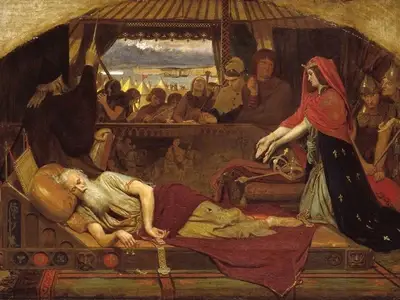Title of Artwork: “Lear and Cordelia”

Artwork by Ford Madox Brown
Year Created 1848
Summary of Lear and Cordelia
The first of three paintings by Brown depicting scenes from Shakespeare’s play King Lear. Drawings made in Paris during the winter of 1843-1844 are the inspiration for all three paintings. William Charles Macready (1793-1873) appeared in a show on May 2, 1848, and in November same year Brown began working on this painting.
All About Lear and Cordelia
An image of Act IV, Scene VII from the play is depicted in the painting Most of Brown’s figures were based on models, although the head of Lear was modelled after “a cast of Dante’s and a drawing of Coulton”.
His favourite model, Maitland, painted the troops on the right, while Dante Gabriel Rossetti, a new student and friend, drew the idiot, who fixes Lear with a malevolent gaze.
He based the head of Cordelia on his soon-to-be wife, Emma, but used a professional model for the hands, Mrs Ashley.
By dressing his figures in 6th-century clothing, Brown attempted to capture the period’s ‘paganism was widespread and deeds were at their darkest’ as described in his 1865 catalogue. The Bayeux Tapestry is featured prominently behind King Lear’s head.
When the painting was first presented in 1849 at the Free Exhibition in London, it was well-received, but no one wanted to buy it. He kept working on it until 1854 when it was purchased by the architect John Seddon for 15 guineas.
Information Citations
En.wikipedia.org, https://en.wikipedia.org/.























